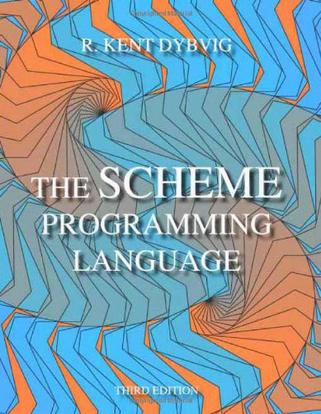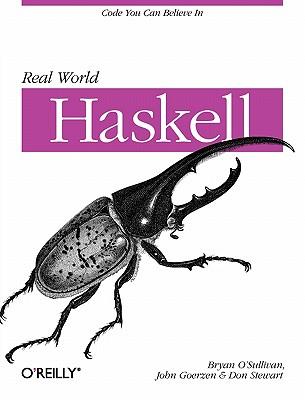欢迎来到相识电子书!
标签:FP
-
The Scheme Programming Language
This thoroughly updated edition of The Scheme Programming Language provides an introduction to Scheme and a definitive reference for standard Scheme, presented in a clear and concise manner. Written for professionals and students with some prior programming experience, it begins by leading the programmer gently through the basics of Scheme and continues with an introduction to some of the more advanced features of the language. Many exercises are presented to help reinforce the lessons learned, and answers to the exercises are given in a new appendix. Most of the remaining chapters are dedicated to the reference material, which describes in detail the standard features of Scheme included in the Revised Report on Scheme and the ANSI/IEEE standard for Scheme. Numerous examples are presented throughout the introductory and reference portions of the text, and a unique set of extended example programs and applications, with additional exercises, are presented in the final chapter. Reinforcing the book's utility as a reference text are appendixes that present the formal syntax of Scheme, a summary of standard forms and procedures, and a bibliography of Scheme resources. The Scheme Programming Language stands alone as an introduction to and essential reference for Scheme programmers. It is also useful as a supplementary text for any course that uses Scheme. The Scheme Programming Language is illustrated by artist Jean-Pierre Hebert, who writes Scheme programs to extend his ability to create sophisticated works of digital art. -
Real World Haskell
This easy-to-use, fast-moving tutorial introduces you to functional programming with Haskell. Learn how to use Haskell in a variety of practical ways, whether it's for short, script-like programs or large and demanding applications. Written for experienced programmers, Real World Haskell takes you through the basics of functional programming at a brisk pace, and helps you increase your understanding of Haskell in real-world issues like I/O, performance, dealing with data, concurrency, and more as you move through each chapter. With this book, you will: Understand the difference between procedural and functional programming Learn about Haskell's compiler, interpreter, values, simple functions, and types Find your way around Haskell's library -- and write your own Use monads to express I/O operations and changes in state Interact with databases, parse files and data, and handle errors Discover how to use Haskell for systems programming Learn concurrency and parallel programming with Haskell You'll find plenty of hands-on exercises, along with examples of real Haskell programs that you can modify, compile, and run. If you've never used a functional language before, and want to understand why Haskell is now coming into its own as a practical language in so many major organizations, Real World Haskell is the place to start. -
Common Lisp
This book is about learning to program in Lisp. Although widely known as the principal language of artificial intelligence research—one of the most advanced areas of computer science—Lisp is an excellent language for beginners. It is increasingly the language of choice in introductory programming courses due to its friendly, interactive environment, rich data structures, and powerful software tools that even a novice can master in short order. When I wrote the book I had three types of reader in mind. I would like to address each in turn. · Students taking their first programming course. The student could be from any discipline, from computer science to the humanities. For you, let me stress the word gentle in the title. I assume no prior mathematical background beyond arithmetic. Even if you don’t like math, you may find you enjoy computer programming. I’ve avoided technical jargon, and there are lots of examples. Also you will find plenty of exercises interspersed with the text, and the answers to all of them are included in Appendix C. · Psychologists, linguists, computer scientists, and other persons interested in Artificial Intelligence. As you begin your inquiry into AI, you will see that almost all research in this field is carried out in Lisp. Most Lisp texts are written exclusively for computer science majors, but I have gone to great effort to make this book accessible to everyone. It can be your doorway to the technical literature of AI, as well as a quick introduction to its central tool. · Computer hobbyists. Prior to about 1984, the Lisps available on personal computers weren’t very good due to the small memories of the early machines. Today’s personal computers often come with several megabytes of RAM and a hard disk as standard equipment. They run full implementations of the Common Lisp standard, and provide the same high-quality tools as the Lisps in university and industrial research labs. The ‘‘Lisp Toolkit’’ sections of this book will introduce you to the advanced features of the Common Lisp programming environment that have made the language such a productive tool for rapid prototyping and AI programming. This current volume of the ‘‘gentle introduction’’ uses Common Lisp throughout. Lisp has been changing continuously since its invention 30 years ago. In the past, not only were the Lisp dialects on different machines incompatible, but programs written in one dialect would often no longer run in that same dialect a few years later, because the language had evolved out from under them. Rapid, unconstrained evolution was beneficial in the early days, but demand for a standard eventually grew, so Common Lisp was created. At present, Common Lisp is the de facto standard supported by all major computer manufacturers. It is currently undergoing refinement into an official standard. But Lisp will continue to evolve nonetheless, and the standard will be updated periodically to reflect new contributions people have made to the language. Perhaps one of those contributors will be you. -
Let Over Lambda
Let Over Lambda is one of the most hardcore computer programming books out there. Starting with the fundamentals, it describes the most advanced features of the most advanced language: Common Lisp. Only the top percentile of programmers use lisp and if you can understand this book you are in the top percentile of lisp programmers. If you are looking for a dry coding manual that re-hashes common-sense techniques in whatever langue du jour, this book is not for you. This book is about pushing the boundaries of what we know about programming. While this book teaches useful skills that can help solve your programming problems today and now, it has also been designed to be entertaining and inspiring. If you have ever wondered what lisp or even programming itself is really about, this is the book you have been looking for. -
Land of Lisp
Lisp is a uniquely powerful programming language that, despite its academic reputation, is actually very practical. Land of Lisp brings the language into the real world, teaching Lisp by showing readers how to write several complete Lisp-based games, including a text adventure, an evolution simulation, and a robot battle. While building these games, readers learn the core concepts of Lisp programming, such as data types, recursion, input/output, object-oriented programming, and macros. And thanks to the power of Lisp, the code is short. Rather than bogging things down with reference information that is easily found online, Land of Lisp focuses on using Lisp for real programming. The book is filled with the author Conrad Barski's famous Lisp cartoons, featuring the Lisp alien and other zany characters. -
Compiling with Continuations
This book shows how continuation-passing style is used as an intermediate representation to perform optimizations and program transformations. Continuations can be used to compile most programming languages. The method is illustrated in a compiler for the programming language Standard ML. Prior knowledge of ML, however, is not necessary, as the author carefully explains each concept as it arises. This is the first book to show how concepts from the theory of programming languages can be applied to the production of practical optimizing compilers for modern languages like ML. All the details of compiling are covered, including the interface to a runtime system and garbage collector. -
The Seasoned Schemer
drawings by Duane Bibbyforeword and afterword by Guy L. Steele Jr.The notion that "thinking about computing is one of the most exciting things the human mind can do" sets both The Little Schemer (formerly known as The Little LISPer) and its new companion volume, The Seasoned Schemer, apart from other books on LISP. The authors' enthusiasm for their subject is compelling as they present abstract concepts in a humorous and easy-to-grasp fashion. Together, these books will open new doors of thought to anyone who wants to find out what computing is really about. The Little Schemer introduces computing as an extension of arithmetic and algebra;things that everyone studies in grade school and high school. It introduces programs as recursive functions and briefly discusses the limits of what computers can do. The authors use the programming language Scheme, and interesting foods to illustrate these abstract ideas. The Seasoned Schemer informs the reader about additional dimensions of computing: functions as values, change of state, and exceptional cases. The Little LISPer has been a popular introduction to LISP for many years. It had appeared in French and Japanese. The Little Schemer and The SeasonedSchemer are worthy successors and will prove equally popular as textbooks for Scheme courses as well as companion texts for any complete introductory course in Computer Science. -
ANSI Common Lisp
For use as a core text supplement in any course covering common LISP such as Artificial Intelligence or Concepts of Programming Languages. Teaching students new and more powerful ways of thinking about programs, this text contains a tutorial-full of examples-that explains all the essential concepts of Lisp programming, plus an up- to-date summary of ANSI Common Lisp, listing every operator in the language. Informative and fun, it gives students everything they need to start writing programs in Lisp both efficiently and effectively, and highlights such innovative Lisp features as automatic memory management, manifest typing, closures, and more. -
ML程序设计教程
本书是关于ML程序设计的经典教材,详细介绍如何使用 ML语言进行程序设计,并讲解函数式程序设计的基本原理。 书中含有大量例子,涵盖了排序、矩阵运算、多项式运算等方面。大型的例子包括一个一般性的自顶向下语法分析器、一个一演算归约程序和一个定理证明机。书中也讲述了关于数组、队列、优生队列等高效的函数式实现,并且有一章专门讨论函数式程序的形式论证。本书的代码均可以从作者网站(http://www.cl.cam.ac.uk/users/lcp/)得到。 本书详细讲解如何使用ML语言进行程序设计,并介绍函数式程序设计的基本原理。书中特别讲述了为ML的修订版所设计的新标准库的主要特性,并且给出大量例子,涵盖排序、矩阵运算、多项式运算等方面。大型的例子包括一个一般性的自顶向下语法分析器、一个l-演算归约程序和一个定理证明机。书中也讲述了关于数组、队列、优先队列等高效的函数式实现,并且有一章专门讨论函数式程序的形式论证。 本书可作为高等院校计算机专业相关课程的教材,也适合广大程序设计人员参考。 -
Clojure in Action
DESCRIPTION Clojure is a new version of Lisp that runs on the Java Virtual Machine. It's a functional language, which means that it's ideal for the growing need for concurrent programming and for specialized tasks like creating domain specific languages. Clojure in Action is a hands-on tutorial for the working programmer who has written code in a language like Java or Ruby, but has no prior experience with Lisp. It teaches Clojure from the basics to advanced topics using practical, real-world application examples. Readers will move quickly through the theory and dive into practical matters like unit-testing, environment set up, and all the way through building a scalable web-application using domain-specific languages, Hadoop, HBase, and RabbitMQ. KEY POINTS * A complete tutorial, from basics to applied techniques * Covers creation of Domain-Specific Languages * Contains numerous practical examples -
The Little Schemer - 4th Edition
This delightful book leads you through the basic elements of programming in Scheme (a Lisp dialect) via a series of dialogues with well-chosen questions and exercises. Besides teaching Scheme, The Little Schemer teaches the reader how to think about computation. The authors focus on ten essential concepts of thinking about how to compute and demonstrate how to apply these concepts in inventive ways. The Little Schemer is an excellent book both for the beginner and for the seasoned programmer.
热门标签
下载排行榜
- 1 梦的解析:最佳译本
- 2 李鸿章全传
- 3 淡定的智慧
- 4 心理操控术
- 5 哈佛口才课
- 6 俗世奇人
- 7 日瓦戈医生
- 8 笑死你的逻辑学
- 9 历史老师没教过的历史
- 10 1分钟和陌生人成为朋友











